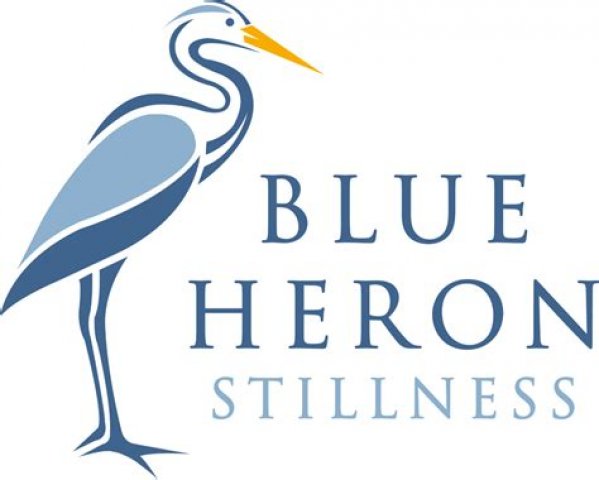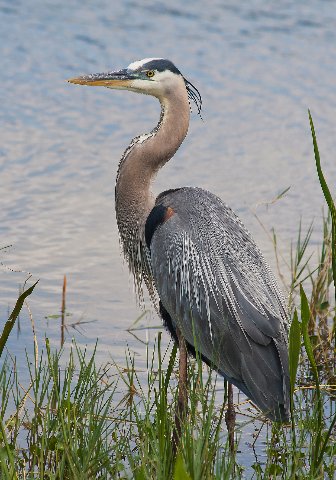Blue Heron's Stillness
By: Cheng Tong - Mar 03, 2024
I got a note from my oldest daughter this week about a blue heron. When my girls were young, we would go to Crab Creek, not far from our house on Cape Cod, and watch for a blue heron. She had seen one at our old place, and wanted me to know.
The creek was a big draw, filled with small fish and frogs, and a great blue heron would sometimes come for a meal. We marveled at how the bird would stand so still and wait so patiently for some unsuspecting food to swim by. Blue Heron Stillness, the name of my school and teaching, came from this experience with my girls.
The blue heron, a majestic bird with piercing yellow eyes and a spear-like beak, embodies a unique paradox. It is a creature of both profound stillness and lightning-fast action. But it is the heron’s stillness that truly captivates, a quality that has enthralled artists, writers, and philosophers for centuries. This stillness isn’t just an absence of movement; it’s a potent force, a language of patience, focus, and a deep connection with the environment.
Standing like a feathered statue, the heron blends seamlessly into the marsh landscape. Its long, slender legs blend with the reeds, its grayish-blue feathers mimicking the water’s reflection. This mastery of camouflage allows the heron to become almost invisible, waiting for the opportune moment to strike. This patient stillness is not merely idleness; it is a calculated strategy honed by evolution. By remaining motionless, the heron conserves energy, minimizes its own footprint in the water, and avoids spooking its prey.
But beneath this surface of tranquility lies a world of keen awareness. The heron’s head, with its large, mobile eyes, scans the water’s surface, its gaze seemingly unblinking. The slightest ripple, a flash of light, or the subtlest vibration in the water will trigger a swift, decisive response. This ability to maintain complete stillness while remaining hyper-alert is a remarkable feat of avian physiology and mental discipline.
The stillness of the blue heron resonates with various cultural and philosophical traditions. In Daoist philosophy, the heron is seen as a symbol of “wu wei,” meaning “effortless action.” The heron teaches that true effectiveness comes not from forceful striving, but from aligning oneself with the flow of nature and acting only when the opportunity presents itself. Similarly, in Zen Buddhism, the heron’s stillness embodies qualities like “zazen” (meditative sitting) and “mushin” (mindfulness), emphasizing the value of quiet observation and being present in the moment.
Observing a blue heron in its stillness can be a deeply meditative experience for humans as well. It forces us to slow down, to become aware of the subtle movements around us, and to appreciate the beauty of simply being. The heron’s stillness reminds us of the power of patience, the importance of focus, and the inherent value of simply being present in the moment. In a world that often values constant activity and busyness, the heron offers a powerful counterpoint, reminding us that sometimes the most effective action is no action at all.
However, the heron’s stillness is not an end in itself; it serves a vital purpose in its survival. When the moment is right, the heron springs into action with astonishing speed and precision. Its lightning-fast strike, often executed with a graceful neck extension and a powerful jab of its beak, reveals the focused energy that has been simmering beneath the surface of its stillness. This sudden burst of movement highlights the dynamic interplay between stillness and action that defines the blue heron’s existence.
The stillness of the blue heron offers valuable lessons for humans in various aspects of life. It teaches us the importance of:
- Patience: The heron’s long periods of stillness teach us the value of waiting for the right opportunity and not rushing into action. In a world obsessed with instant gratification, the heron reminds us that slow and steady often wins the race.
- Focus: The heron’s unwavering attention to its prey teaches us the importance of maintaining focus and not allowing distractions to derail us from our goals.
- Mindfulness: By observing the heron’s stillness, we can learn to cultivate a deeper sense of awareness of ourselves and the world around us. This mindfulness can help us navigate life’s challenges with greater clarity and equanimity.
- Acceptance: The heron’s stillness also embodies a sense of acceptance of the present moment. It reminds us that we cannot control everything, but we can choose how we react to situations.
The blue heron’s stillness is not merely an absence of movement. It is a powerful force, a language of patience, focus, and a profound connection with the environment. By observing and learning from the heron’s stillness, we can gain valuable insights into ourselves and the world around us, fostering a deeper sense of peace, awareness, and connection in our own lives.


